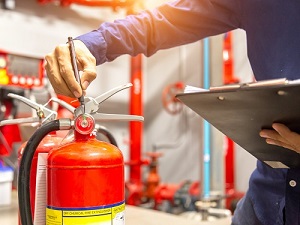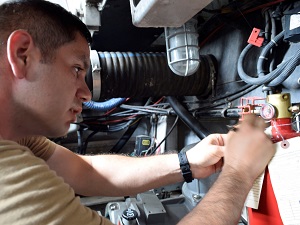All fire extinguishers should be inspected regularly. Learn more about workplace fire extinguisher inspection requirements and recommendations including best practices for conducting a monthly visual inspection.

All firefighting equipment, including fire extinguishers, must be periodically inspected and receive routine maintenance on a regular basis to ensure they are operating properly and ready, if needed. Portable fire extinguishers should be inspected by a trained professional once a year with a visual inspection conducted monthly.
OSHA General Industry Standard 1910.157(e) Portable extinguishers shall be visually inspected monthly. The employer shall assure that portable fire extinguishers are subjected to an annual maintenance check.
Visual inspections are quick checks to ensure that the fire extinguisher is fully charged, in good operating condition and ready for use, should it be needed. During monthly inspections also check the surrounding area to ensure the fire extinguisher remains easily accessible in the event of an emergency.
OSHA Construction Standard 1926.150(a)(4) All firefighting equipment shall be periodically inspected and maintained in operating condition. Defective equipment shall be immediately replaced.

All employees should be familiar with the location of the fire extinguishers in the work area. Fire extinguishers may be stored in fire hose or fire extinguisher cabinets, on wall-mounted or post-mounted brackets or other safe, but accessible storage areas. They might be kept in specific rooms, in hallways, near stairways, or close to a specific work area.
OSHA General Industry Standard 1910.157(d)(1) Portable fire extinguishers shall be provided for employee use and selected and distributed based on the classes of anticipated workplace fires and on the size and degree of hazard which would affect their use.
Understand the type of fire extinguisher available and the class of fire it is rated to be used on. The class of fire extinguisher must match the type of fire, especially if combustible metals, electricity, or oils or grease are present in the area of the work. Portable fire extinguishers are labeled with color-coded letters and/or pictograms that indicate the type of fire they are designed to extinguish. Using the wrong type of fire extinguisher could be ineffective, result in electrical shock, cause an explosion or even spread the fire.
Reminder: Portable fire extinguishers are useful for putting out small fires, but they are not effective against larger fires or fires that are spreading quickly.
OSHA Construction Standard 1926.352(d) Suitable fire extinguishing equipment shall be immediately available in the work area and shall be maintained in a state of readiness for instant use.
A visual inspection of portable fire extinguishers, including the area where the extinguishers are located, should be conducted once a month. Anyone can perform the visual inspection, if trained to do so. Keeping a record of the visual inspection is recommended, but not required.
Every year an inspection is required by a licensed fire extinguisher maintenance contractor who will ensure the extinguishers are fully pressurized, the correct weight and damage-free. If the fire extinguisher fails the inspection it will need to be replaced. Annual inspections may also require a pull test on the pin and a seal replacement. The inspector will provide a dated inspection tag. At the time of the annual inspection it is recommended to review inspection documentation to ensure it is complete, stored properly, and the appropriate personnel know where and how to access the records.
There are also 6-year maintenance as well as hydrostatic testing requirements for some fire extinguishers. The licensed inspector who conducts the annual inspections will provide guidance on these additional testing and maintenance requirements.

During the monthly visual inspection of all portable fire extinguishers, it is important to look for the following:
- Verify that the fire extinguisher is in the correct location and that it hasn’t been moved or taken out of service.
- Confirm that the fire extinguisher is mounted in a highly visible location or stored in an easy to locate area and will be easily accessible during an emergency.
- Ensure the path to get to the fire extinguisher is also clear and is not obstructed by equipment, materials or other items.
- Verify that the indicator on the pressure gauge is in the green operating range.
- Confirm the pull-pin is intact and the tamper-seal is not broken or missing.
- Check for the inspection tag, which should indicate that the last annual inspection was conducted within the previous 12 months.
Also, during the visual inspection, it’s important to check the fire extinguisher for any obvious physical damage.
- Ensure that the label is readable.
- Check that the fire extinguisher does not have any signs corrosion, dents or leakage.
- Verify any hoses are still in good condition and do not have cracks or other damage.
- Take a look inside the nozzle to ensure it has not been clogged by insects or debris.

During the monthly visual inspection take the opportunity to clean off any fire extinguishers that might need it, especially if the extinguisher is covered in dust, grease, paint or sawdust.
When checking the pressure gauge, a needle within the green zone is good. A needle in the left red zone means that the fire extinguisher is depressurized and a recharge is required. A needle in the right red zone signals a danger of over pressure.
Note: Carbon Dioxide extinguishers do not have a pressure gauge. The only method for verifying a carbon dioxide extinguisher is fully-charged is to weigh the unit, and weighing extinguishers is typically outside the scope of the normal monthly visual inspection.
When portable fire extinguishers are removed from service for maintenance, an alternative must be provided.
For particularly dirty worksites, consider adding a removable cover to protect fire extinguishers.
Report missing, damaged or used fire extinguishers immediately.

.jpg)


.jpg)
.jpg)